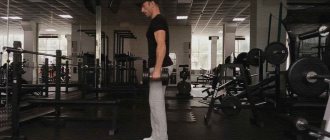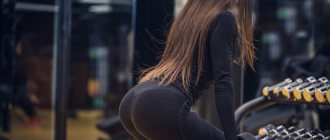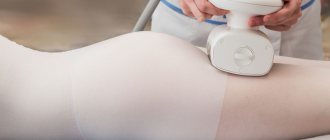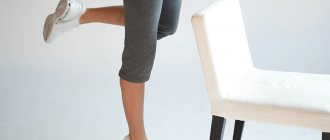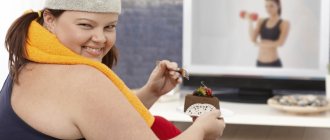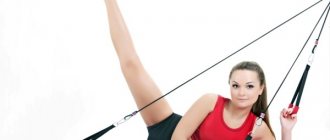Why These Butt Exercises Work
Because they are selected taking into account anatomy.
The Lifehacker Telegram channel contains only the best texts about technology, relationships, sports, cinema and much more. Subscribe!
Our Pinterest contains only the best texts about relationships, sports, cinema, health and much more. Subscribe!
The gluteus maximus muscles extend the hip or, in other words, take it back. There are several positions in which these muscles are activated better:
- If the hip does not flex. When you flex it, such as during squats, gluteus muscle activity decreases. Influence of joint position on electromyographic and torque generation during maximal voluntary isometric contractions of the hamstrings and gluteus maximus muscles. Therefore, the best exercises for the buttocks involve hip extension without preliminary flexion.
- If the hip is abducted to the side at an angle of 30 degrees. The fibers of the gluteal muscle run diagonally from top to bottom. Therefore, when the hip is directly under the body, the gluteal muscle tenses worse than if it is abducted Activation of the gluteus maximus and hamstring muscles during prone hip extension with knee flexion in three hip abduction positions to the side.
- If the knee is bent Muscular activation patterns during active prone hip extension exercises at an angle of 90 degrees. When you keep your knees bent, the gluteal muscles contract well when you extend your hips. But if you simultaneously extend your knees and hips, as in squats, deadlifts and buttock machines, the muscles are worked much worse. EMG activities in mono- and bi-articular thigh muscles in combined hip and knee extension.
- When the toes are turned outward Muscular activation patterns during active prone hip extension exercises, Influence of Hip Joint Position on Muscle Activity during Prone Hip Extension with Knee Flexion .
How and how much to exercise
If you're working your entire body in one workout, do it at least three times a week. Choose one exercise from the list and include it in your program. To avoid stagnation, change exercises after 1-2 workouts.
If you prefer splits, choose 1-2 movements and perform them on leg day. Keep in mind that most glute exercises also work the hamstrings. So if you want to do heavy deadlifts or leg presses on the machine, it's better to start with them. Otherwise, your muscles will get tired and you won’t be able to give it your all.
If you are only interested in the buttocks, do the exercises at the beginning of your workout. This way you can maximally load your muscles and ensure their growth.
Do 3-5 sets of 8-12 reps. Select the weight so that the last repetitions of the set are difficult. Perform the final approach until the muscles fail. Rest 90–120 seconds between sets.
What exercises are most effective for the buttocks?
Raising the pelvis with support on the bench
Sit on the floor, lean your back on the bench. Place the barbell on your hips, bend your knees and place your feet on the floor shoulder-width apart, with your toes slightly turned out to the sides. It's good to have a soft grip on the bar, otherwise it will dig into your body when you load the weight.
Raise your pelvis so that your body is extended in one line, hold for 2-3 seconds, lower back down and repeat.
Glute bridge with weights
Lie on the floor, place the barbell on your hips, bend your knees and place your feet shoulder-width apart, with your toes slightly turned out to the sides. Holding the projectile with your hands, lift your pelvis as high as possible. Hold at the extreme point for 2 seconds and lower back down. Repeat the exercise.
Traction in the crossover between the legs
Attach the rope handle to the lower crossover block. Stand with your back to him, grab the handle with both hands, take two steps forward. Place your feet slightly wider than shoulder-width apart, with your toes pointing out to the sides.
Bend forward with your back straight until your body is parallel to the floor - this is the starting position. Tightening your buttocks, straighten your body, pause for a second at the extreme point and return to the starting position.
Russian kettlebell swings
Same as crossover deadlift, only with a kettlebell. Place your feet slightly wider than shoulder-width apart, with your toes pointing out to the sides. Take the apparatus in your hands, move your pelvis back, lean forward with a straight back and place the weight between your legs.
Tightening your buttocks, straighten up in your pelvis and swing the apparatus to the level of your collarbones. Then place the kettlebell between your legs again and repeat the swing. There is no need to bend your knees too much: the main movement occurs in the hip joint.
Reverse hyperextension
Lie your body on a bench or GHD machine so that your legs remain suspended, hold on with your hands. Bend your knees at right angles. Keep your thighs parallel to the floor. From this position, lift them and lower them back.
There are two ways to make the exercise more difficult:
- Weighting your legs. Take a special belt, hang a plate with the required weight on it and ask it to be thrown over your feet when you take the starting position.
- Place an expander on your knees and spread your legs to the sides. So you will have to not only raise your legs, but also apply force to keep them apart.
Hip abduction in crossover
Hook your leg to the lower block and stand facing the machine. You can hold onto the racks with your hands. Without bending your knee, take your leg back, fix it at the extreme point and return to its original position.
The best exercises for hips and buttocks
Gluteal bridge
Lie on your back, knees bent, feet on the floor (shoulder-width apart), arms at your sides. Slowly lift your hips off the floor toward the ceiling and squeeze your buttocks and thighs.
Hold for 1 second and then slowly lower your pelvis down. Raise your hips up again and repeat the exercise 60 times.
Exhale as you raise your hips and inhale as you lower them.
Alternating leg swings for the buttocks
Lower yourself onto your forearms and knees, bending your legs at a 90-degree angle. The head is raised, the abs tense, the back is straight. Lift your right leg, bent at the knee, straining the muscles of your right buttock, with your heel toward the ceiling.
Don't arch your back. Slowly return your leg to the starting position and repeat this exercise 20 times on each side.
Exhale as you lift your leg and inhale as you lower it.
How to pump up the upper buttocks at home
Try the best exercises to tone your upper butt at home. The video will show you how to add mass to your butt to make it more voluminous and appetizing.
Leg swings for outer thighs
Lie on your right side. Bend your right elbow and lean on it to support your upper body. Keep your hips straight and your stomach tense. Bend your left leg at a 45-degree angle in front of you. Place your left palm on the floor in front of your chest to provide better balance and support.
Keep your left leg straight and slowly lift it up, just above head level. Hold for one second, contracting your outer thigh muscles as much as possible. Then bring your leg back down without touching your bottom leg. Complete 30 reps. Then lie on the other side and do the same number of exercises with your right leg.
Exhale as you lift and inhale as you lower your leg.
Leg swings for the inner thighs
Lie on your right side, with your right arm extended straight, in line with your torso. Place your head on it and place your left hand on the floor in front of your chest. Bend your top leg and place it overlapping your bottom leg. There should be no support on the knee. Use your left hand to support your body.
The bottom leg lies straight, with the inside of the foot facing the ceiling. Using your adductors (inner thigh muscles), slowly lift your leg up as high as you can. Then slowly lower it down. Perform 30 times and then repeat the entire sequence on the other side.
Exhale as you lift and inhale as you lower your leg down.
Squats for buttocks and thighs
Feet shoulder-width apart, hands on hips. Keep your back straight, your eyes looking forward, your abs tense. Slowly bend your knees, lowering yourself into a squat (at a 90-degree angle) as if you were about to sit down.
Lean your torso back and put your weight on your heels. Hold this position for three seconds and squeeze your gluteal muscles as much as you can while lifting yourself up. The knees should not extend beyond the line of the toes. Perform three sets of 20 repetitions.
Inhale deeply as you go down and exhale as you go up.
Lunges
Stand straight, legs together, back straight, stomach pulled in. Looking straight ahead, take a big step forward with your right foot. Bend both knees as you move down.
Once you reach 90 degrees, make sure your front knee is behind your toes. This will prevent unnecessary stress on the knee joints. Shift your weight to your front leg and use your back leg as a balancer.
Slowly return to the starting position, pushing through your front heel. Do 20 exercises on each side.
Exhale as you lunge and inhale as you return to the standing position.
LUNCH TECHNIQUE | Exercises for the buttocks - video
How to Do Squats, Deadlifts, and Lunges to Target Your Glutes
These exercises are not as effective as the ones above. But if you don't have time and need to hit your entire lower body at once, simply change the position of your legs and shift the emphasis to the buttocks.
Squats
Perform sumo squats: place your feet twice as wide as your shoulders, pointing your toes out to the sides.
If you are performing a squat with a plate or dumbbells, extend the apparatus in front of you. This way you will increase the abduction of the pelvis back and strengthen the development of the buttocks.
Deadlift
Do sumo deadlifts: with your feet wide and your toes turned out to the sides. This will only slightly increase the load on the buttocks, but it’s still better than nothing.
Lunges
During lunges, lean your body forward.
Leg press in the gym
Place your feet at the top of the platform, spread your legs wider and point your toes out to the sides.
Why do you need to train your leg muscles?
By properly combining aerobic and strength training, you can quickly achieve impressive results. So, by including movements aimed at working the leg muscles into your usual training program, you will be able to:
- burn more calories in one session;
- make the body more resilient and strong;
- strengthen the spine, hip and back muscles.
In addition, well-developed legs significantly reduce the likelihood of injuries and sprains during training. And also, by training your lower limbs, you simultaneously strengthen your cardiovascular system.
To exercise, you don't have to purchase a gym membership. Just take note of a few videos of leg exercises at home. Which we will present below.



